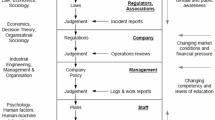Abstract
In the petroleum industry, new technologies and work processes are currently being developed as an innovation strategy for better, faster and safer drilling. In this article, some features of today’s work processes that contribute to successful operations are presented and discussed. The articulation work involved in handling the transient complexity of operations involves making black-boxed and invisible work processes visible and transparent. It is argued that this articulation work contributes to the organisation’s understanding and knowledge of the drilling processes and the dependencies that exist between different actors. In addition to contributing to ongoing problem solving, the articulation work also contributes to the awareness of possible future events. Following this insight, it is argued that efforts to improve operational efficiency and safety by introducing new tools and work processes should focus not only on the capability of new tools to support decisions and actions by instrumentation and automation, but attention should also be paid to the existing articulation work and its role in the accomplishment of work. In that way, the contributions of today’s articulation work can be strengthened instead of lost, and the outcome of the change processes can be even better than anticipated.


Similar content being viewed by others
Explore related subjects
Discover the latest articles, news and stories from top researchers in related subjects.Notes
The derrickman is in charge of the mud-processing area. Roughnecks are low-ranking members of the drilling crew. The mud logging company’s responsibility is primary well control.
The mud serves several different functions in a drilling operation. Firstly, it transports drilled cuttings from the bottom of the well to the surface. If this transport fails, the drill string might get stuck because of accumulation of cuttings in the well. At the surface, the cuttings are separated from the mud at vibrating sieves, called shale shakers. Secondly, the mud functions as a barrier against gases and fluids in the formations. Other functions involve using mud pulses to transport signals from between technical equipment downhole and control and interpretation equipment topside.
The shaker hand is a crew member dedicated to watching the shakers. However, he does not do this continuously as this is not his only task.
12 ¼″ (inches) and 8 ½″ are standard diametrical dimensions for drill pipes. In a drilling operation, one starts out with a large diameter and ends up with a smaller. In a typical well, the series of sections will be 36″, 26″, 17 ½″, 12 ¼″ and 8 ½″.
References
Bannon L, Bødker S (1997) Constructing common information spaces. In: Proceedings of the fifth conference on European conference on computer-supported cooperative work ECSCW’97. Kluwer, Lancaster, UK, pp 81–96
Garfinkel H, Rawls AW (2002) Ethnomethodology’s program: working out Durkheim’s aphorism. Rowman & Littlefield Lanham, Boulder
Gerson EM (1986) Analyzing due process in the workplace. ACM Trans Inf Syst 4:257–270
Glaser BG (1994) More grounded theory methodology: a reader. Sociology Press, Mill Valley
Glaser BG, Strauss AL (1967) The discovery of grounded theory: strategies for qualitative research. Aldine, Chicago
Hampson I (2005) Invisible work, invisible skills: interactive customer service as articulation work. New Technol Work Employ 20:166–181
Hollnagel E (2009) The ETTO principle: efficiency-thoroughness trade-off—why things that go right sometimes go wrong. Ashgate, Aldershot
Hollnagel E, Woods DD (2005) Joint cognitive systems: foundations of cognitive systems engineering. Taylor & Francis, Boca Raton
Hollnagel E et al (eds) (2006) Resilience engineering: concepts and precepts. Ashgate, Aldershot
Hutchins E (1995) Cognition in the wild. MIT Press, Cambridge
IHRDC (International Human Resources Development Corporation) (2009) Drilling&Well completions—overview. http://www.petroleumonline.com. Accessed 28 May 2009
LaPorte TR, Consolini PM (1991) Working in practice but not in theory: theoretical challenges of “high-reliability organizations”. J Public Adm Res Theory 1:19–48
Latour B (1986) Visualization and cognition: thinking with eyes and hands. Knowl Soc 6:1–40
Latour B (1999) Circulating references. Sampling the soil in the Amazon Forest. In: Latour B (ed) Pandora’s hope: essays on the reality of science studies. Harvard University Press, Cambridge, pp 24–79
Latour B (2005) Reassembling the social: an introduction to actor-network-theory. Oxford University Press, Oxford
Perrow C (1984) Normal accidents: living with high-risk technologies. Basic Books, New York
Roth EM et al (2006) Shared situation awareness as a contributor to high reliability performance in railroad operations. Organ Stud 27:967–987
Schmidt K (1996) Coordination mechanisms: towards a conceptual foundation of CSCW systems design. Comput Supported Coop Work 5:155–200
Schmidt K, Bannon L (1992) Taking CSCW seriously: supporting articulation work. Comput Supported Coop Work 1:7–40
Star SL, Strauss A (1999) Layers of silence, arenas of voice: the ecology of visible and invisible work. Comput Supported Coop Work 8:9–30
Strauss A (1985) Work and the division of labor. Sociol Q 26:1–19
Suchman L (1993) Centers of coordination: a case and some themes. In: Resnick LB (ed) Discourse, tools, and reasoning: essays on situated cognition. Springer, Berlin, pp 41–62
Suchman L (1995) Making work visible. Commun ACM 38:56–64
Suchman L (1996) Supporting articulation work. In: Kling R (ed) Computerization and controversy: value conflicts and social choices. Academic Press, San Diego, pp 407–423
Weick KE (1993) Collective mind in organizations: heedful interrelating on flight decks. Adm Sci Q 38:357–381
Weick KE (1999) Organizing for high reliability: processes of collective mindfulness. Res Organ Behav 21:81–123
Woods DD (2006) Essential characteristics of resilience. In: Hollnagel E, Woods DD, Leveson N (eds) Resilience engineering: concepts and precepts. Aldershot, Ashgate, pp 21–34
Acknowledgements
This research has been funded by the Norwegian Research Council’s Petromaks programme.
Author information
Authors and Affiliations
Corresponding author
Rights and permissions
About this article
Cite this article
Haavik, T. Making drilling operations visible: the role of articulation work for organisational safety. Cogn Tech Work 12, 285–295 (2010). https://doi.org/10.1007/s10111-010-0139-2
Received:
Accepted:
Published:
Issue Date:
DOI: https://doi.org/10.1007/s10111-010-0139-2




